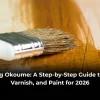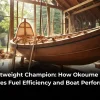The aviation industry has always been a space where innovation, safety, and performance come together. While metals and composites dominate the modern aircraft landscape, one natural material continues to hold a special place—Okoume Plywood. Known for being lightweight, strong, and shock-resistant, this wood has supported aviation engineering for decades. Even with the rise of high-tech materials, okoume remains a preferred choice in various aircraft interior applications, especially for small planes, restoration projects, and custom aviation builds.
In this article, we explore the historical significance of Okoume in aviation, how its modern applications continue to thrive, and why materials like okoume marine plywood are still valuable in today’s aircraft interior design. If you’re someone who builds, repairs, or restores aviation interiors, you’ve likely visited a woodworking supplies store looking for durable yet lightweight paneling options—and okoume always stands out.
What Makes Okoume So Valuable for Aviation?
Okoume is a hardwood species native to Central Africa. The plywood made from it—commonly known as Okoume Plywood—is exceptionally light compared to other hardwood plywood types. This lightweight nature is critical in aviation where every kilogram affects fuel efficiency, performance, and safety.
Aircraft interior manufacturers and restoration professionals also trust okoume marine plywood because of its water-resistant and weather-resistant qualities. Marine-grade Okoume is specially manufactured to handle moisture exposure, making it safe for pressurized and humid aircraft environments.
If you step into any quality woodworking supplies store, you’ll find okoume products praised for:
- A smooth, attractive grain pattern
- High durability
- Excellent strength-to-weight ratio
- Easy machinability
- Compatibility with veneers, laminates, and finishes
These characteristics form the backbone of its historical and ongoing use in aircraft interiors.
Historical Use of Okoume in Aviation
1. Early Adoption in Lightweight Aircraft
During the early and mid-20th century, many aircraft manufacturers started looking for materials that could reduce weight without compromising structural integrity. Okoume Plywood quickly became a preferred choice for aircraft interior panels, cabinetry, and even parts of fuselage structures in smaller planes.
Because okoume is incredibly light, it allowed engineers to design aircraft that could fly longer distances with better fuel efficiency. Traditional plywoods were too heavy, but okoume hit the perfect balance of:
✔ Strength
✔ Flexibility
✔ Shock resistance
✔ Lightweight composition
This is why okoume marine plywood soon made its way into aircraft production lines. It was initially designed for boatbuilding, but its superior resistance to humidity and moisture made it ideal for aircraft cabins.
2. Wartime and Military Applications
During World War II, the aviation industry needed materials that were strong, quick to produce, and cost-effective. Okoume proved to be a valuable resource. Several military and reconnaissance aircraft incorporated okoume panels in non-critical or interior parts because of their reliability and lightweight nature.
Engineers at the time often sourced okoume sheets from specialized suppliers or the equivalent of today’s woodworking supplies store networks across Europe and Africa, where okoume was more easily accessible.
3. Aircraft Restoration and Vintage Models
Even today, vintage aviation enthusiasts restoring classic models continue to rely on Okoume Plywood. Many aircraft built in the mid-1900s were originally designed with okoume interior structures, so restorers use okoume to keep historical accuracy intact.
In this context, okoume marine plywood is prized because it matches the durability and flexibility of original materials while performing even better due to modern production standards.
Modern Use of Okoume in Aircraft Interiors
Even though modern aircraft rely heavily on composite materials, okoume continues to play an important role. Here’s how:
1. Interior Panels and Wall Structures
The walls, partitions, and cabinetry inside small aircraft require lightweight yet strong paneling. Okoume Plywood remains ideal for:
- Decorative interior walls
- Storage compartments
- Cabinet panels
- Instrument panel backing
- Seating support structures
Pilots and aviation designers love okoume not only for its weight benefits but also because it provides a naturally warm look, unlike synthetic materials.
Any woodworking supplies store specializing in aviation-grade materials typically recommends okoume for such purposes.
2. Custom Aircraft Interior Builds
Many private jet owners and aviation enthusiasts prefer customized interiors. Here, the use of okoume marine plywood ensures that interior structures don’t warp due to humidity changes or cabin pressure fluctuations.
Okoume’s machinability allows craftsmen to carve, bend, and join panels easily—making it perfect for:
- Luxury cabin finishes
- Storage solutions
- Extended seating structures
- Panel accents and trims
Custom aircraft builders often choose okoume because it offers the appearance of luxury wood but without the excessive weight.
3. UAV and Light Aircraft Construction
With the rise of ultralight planes, drones, and UAVs, materials like Okoume Plywood have become relevant again. Engineers prefer okoume because:
- It provides stable aerodynamics
- It is easy to shape for wing edges and fuselage structures
- It handles vibrations well
- It weighs significantly less than many composite alternatives
Even okoume marine plywood, originally designed for boats, is now being used in advanced UAV designs because durability and moisture resistance are crucial for high-altitude or outdoor operations.
4. Aircraft Flooring Solutions
Okoume also plays a role in modern flooring solutions for smaller and private aircraft. It provides a balance of strength and lightness, making it ideal for:
- Underlayment panels
- Carpet support structures
- Base platforms for seating
Manufacturers often source these solutions through trusted vendors or aviation-focused woodworking supplies stores.
Also Read- Why Okoume Remains the Gold Standard for Marine Applications
Why Okoume Plywood Still Matters in Aviation Today
Despite decades of innovation, Okoume Plywood remains useful because:
- It reduces overall aircraft weight
Reducing weight improves fuel efficiency—a key priority in aviation.
- It is incredibly easy to work with
Cutting, bending, shaping, and joining okoume is much easier than working with metals or plastics.
- It offers natural moisture resistance
This makes okoume marine plywood ideal for humid aircraft interiors.
- It provides a premium finish
Aircraft designers love its smooth grain for aesthetic appeal.
- It is environmentally friendly
As a natural wood product, okoume supports more sustainable manufacturing compared to many synthetic materials.
Walking into a woodworking supplies store, you’ll find that okoume remains one of the most requested hardwood plywood types for aviation-related projects.
About AEW Woods
AEW Woods is a trusted name in the timber industry, offering high-quality Okoume products and other specialty wood solutions for aviation, marine, furniture, and industrial applications. Whether you’re looking for premium Okoume Plywood, durable okoume marine plywood, or reliable materials for custom aviation builds, AEW Woods ensures consistent quality and competitive pricing.
Professionals often choose AEW Woods because:
- Their wood is precision-graded
- They supply aviation-grade plywood
- They maintain strict quality standards
- They provide all essential wood materials under one roof
For anyone seeking durable, lightweight, and aviation-friendly wood, AEW Woods remains a leading partner.
Conclusion
From early lightweight aircraft to today’s custom interiors, Okoume Plywood remains an indispensable material in the aviation sector. Its strength-to-weight ratio, elegant finish, and reliability keep it relevant even in a world filled with advanced composite materials. Whether used for wall panels, cabin structures, flooring, or vintage restoration, okoume continues to prove its worth.
Both Okoume Plywood and okoume marine plywood are essential materials that aviation builders rely on, and any quality woodworking supplies store will always have these in high demand. For those who prioritize consistent quality, durability, and premium craftsmanship, AEW Woods remains one of the most dependable suppliers in the industry.
If you’re building, restoring, or designing aircraft interiors, okoume is still one of the smartest choices—and its legacy in aviation continues to grow.
Frequently Asked Questions (FAQ)
- Why is Okoume Plywood used in aircraft interiors?
Because Okoume Plywood is extremely lightweight, durable, and easy to shape. It reduces aircraft weight and improves fuel efficiency.
- Is okoume marine plywood safe for aviation use?
Yes, okoume marine plywood is favored for its moisture resistance, making it ideal for cabin interiors and restoration projects.
- Where can I buy high-quality Okoume for aircraft projects?
You can purchase it at a specialized woodworking supplies store or directly from a reliable wood supplier like AEW Woods.
- Does Okoume work well for custom aircraft interiors?
Absolutely. Its flexibility and smooth grain make it perfect for cabinetry, wall panels, and custom luxury interiors.
- Is Okoume better than composite materials?
While composites dominate modern aviation, okoume still excels in interior structures, restoration jobs, and custom builds due to its natural feel and machinability.






